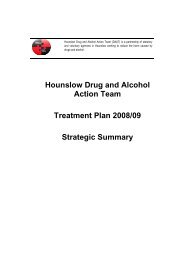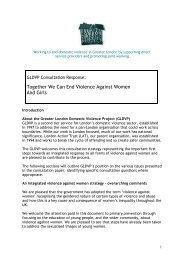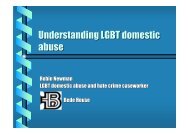1 Domestic violence information
Theory and Practice for the Substance Misuse Sector (pdf - AVA
Theory and Practice for the Substance Misuse Sector (pdf - AVA
Create successful ePaper yourself
Turn your PDF publications into a flip-book with our unique Google optimized e-Paper software.
Using Treatment Outcomes Profiles (TOP) and Care Planning<br />
to address domestic <strong>violence</strong><br />
We know that many victims (and perpetrators) will not disclose<br />
experiences of domestic <strong>violence</strong> at initial assessments. However,<br />
disclosures might be made later when you have established more<br />
of a relationship with the service user.<br />
The answers to some of the TOP questions/monitoring could alert<br />
a practitioner to the possibility of domestic <strong>violence</strong> and therefore<br />
could provide the opportunity to explore the issue further.<br />
Questions on mental, physical health, quality of life, social circumstances<br />
and offending could all open a window of opportunity to<br />
address domestic <strong>violence</strong> with service users.<br />
For example, a question about quality of life and relationships<br />
with partner and family could be followed by a question about<br />
whether your service user is frightened of anyone at home or<br />
whether they have done anything they regret towards a partner<br />
when they are using/drinking.<br />
3.4 Documentation for client files<br />
The following is taken from Refining the Routes, <strong>Domestic</strong> Violence<br />
and Substance Misuse: Policies, Procedures and Protocols for<br />
Camden (2007).<br />
It is important to keep accurate, concise, relevant and up to date<br />
records of all incidents of domestic <strong>violence</strong> that a client discloses. All<br />
notes should be written during the session with the client, agreed by<br />
the client, and signed and dated.<br />
It is possible that these case notes may be used for legal purposes in<br />
the future, and thus will be beneficial for the client should they wish to<br />
pursue the abuse through legal channels.<br />
These records will be stored with the agency. The client should be<br />
offered the option of receiving a copy. However, it is important to<br />
advise clients that it may not be safe to keep records at home or<br />
on their person as they may be discovered by the perpetrator.<br />
Any documentation will include the record of the routine inquiry, the<br />
client responses (including types of abuse experienced with examples<br />
given by the client and any context).<br />
The worker’s response including discussion of options and <strong>information</strong>giving,<br />
risk assessment, any injuries that have been noted, any referrals<br />
made, any safety plans, and scheduled follow-up appointments.<br />
Even if domestic <strong>violence</strong> is not identified as an issue, it should still be<br />
documented that the worker inquired about it, and the client response.<br />
If the worker did not inquire about domestic <strong>violence</strong> as part of this<br />
<strong>Domestic</strong> Violence Routine Inquiry Policy, this should also be<br />
documented with the reasons why this did not occur.<br />
Possible reasons could relate to issues of safety. For example, if the<br />
client was accompanied by the perpetrator or by anyone else, if it<br />
was not possible to speak in a confidential setting, or if the client left<br />
before the appointment was completed.<br />
124<br />
© Stella Project Section 3 - <strong>Domestic</strong> Violence<br />
© Stella Project Section 3 - <strong>Domestic</strong> Violence 125












